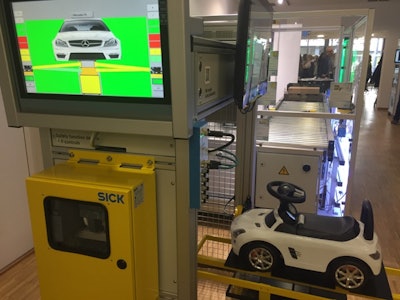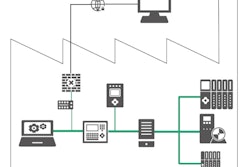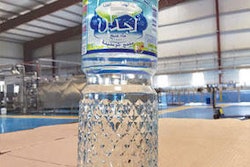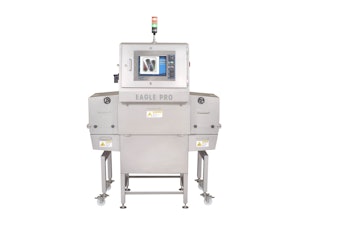Automated industrial applications have long been the realm of sensors and controllers. However, as controllers evolve from their historically central position on the plant floor to become increasingly positioned in cloud and edge locations, the core of automated industry is fast becoming the realm of sensors and networks.
To read more about the transition of controllers the cloud and edge locations, see “Automation Networks: From Pyramid to Pillar."
Just as the first industrial revolution centered on steam, the second industrial revolution centered on electric technologies and the third on control technologies, the fourth industrial revolution is all about networking, says Bernhard Mueller, a member of the management board at Sick. As a result of this focus on networking, the industry needs intelligent edge devices to make decisions about all the incoming sensor data to determine what should be sent to the cloud for analysis, and what should be handled on-premise at the edge or controller level, Mueller says. What makes sensor intelligence so important, he adds, is that this latest revolution is ultimately driving toward a lot size of one via transparent, dynamic and flexible production methods and high factory availability.
Sick, a global supplier of industrial sensing technologies, currently offers some 40,000 different sensor and sensor-related products, according to Dr. Robert Bauer, chairman of the company's executive board. Those products are concentrated on applications in factory automation, logistics automation and process automation for presence detection, safety, data analysis, flow measurement, integration (i.e., apps to integrate data from different sources), industrial systems, motion control, identification and measurement.
To target its work on the industry’s evolving needs, Sick devotes 10 percent of its annual sales revenues to R&D, according to Anne Hegemann, head of organization and people development at Sick. Based on its current fiscal year earnings, this translated to 169.4 million Euros spent on R&D in 2017 vs 143.4 million Euros in 2016—a year-over-year increase of 18 percent.While attending a recent press event at Sick’s headquarters in Waldkirch, Germany, I saw a wide range of sensor technologies on display covering gas analysis, dust measurement, presence detection (photoelectric and proximity) and fluid measurement, as well as 2D and 3D vision systems, distance sensors, identification systems, motor feedback systems, safety laser scanners, safety control and safety switches, light curtains, safety camera systems, automation light grids and registration sensors.
These sensors are designed to collect more information about objects that can then be shared with higher level technologies, such as MES or ERP systems.
Amid this broad display of sensing technologies, three areas stood out as key factors for the near-term future of the industry: Automated guided vehicles (AGVs), vision systems and smart sensors.
AGVs: In Sick’s display of trends in this area, the company highlighted how Daimler is moving away from long, linear assembly lines toward the use of discrete production cells. This means the company is relying on AGVs to move car bodies and components from cell to cell. To do this safely and effectively, they needed adaptive scanning solutions—which involve the integration of sensors and cameras—for the AGVs to manage the movement of car bodies and parts into and out of production areas. The AGVs use these sensor systems to detect their speed and direction, objects in their path, and their approach to machine or production cells. Sensor technologies on the AGVs are also used to track and trace materials as they are transported around the factory. According to Sick, Daimler has started using these AGV sensing technologies in its Tuscaloosa, Alabama plant, as well as in its new plants in Hungary and China.
Vision: A key new product released by Sick a few years ago is its AppSpace technology. This is an app development program for end users that allows them to develop custom apps for any kind of Sick sensor through a common platform. On display during the press event at Sick was the company's Inspector P2D camera system, which can be programmed with AppSpace to perform everything from quality pass/fail inspections to robot picking and sorting applications. This camera, according to Sick, is known for its ability to detect specific points at speeds up to 120 mph, as shown at the event on a rail car inspection application. Also shown was Sick’s Ranger3 camera for 3D part detection and analysis. Sick also offers the Trispector P1000 camera system, which is similar to the Inspector P system, but for 3D analyses that can be performed onboard the camera.
Smart sensors: These sensors, Sick says, are not just about common sensor applications such as detection or measurement, though this is at the core of the functions they perform. The difference is that they’re also designed to collect more information about objects that can then be shared with higher level technologies, such as manufacturing execution systems or enterprise resource planning systems. In an application highlighting the capabilities of these sensors, Sick showed how using their leading- and trailing-edge measurement analysis capabilities for speed calculations offers an advantage over performing such calculations in a programmable logic controller (PLC). Performing this analysis on a PLC requires the controller to address four parameters (i.e., leading- and trailing-edge measurements of an object as it moves past two sensor locations). Having the two sensors perform this task directly leads to higher repeatability, and therefore accuracy, says Sick. The key to Sick’s smart sensors is the use of an embedded microcontroller unit (MCU) in the sensor to handle the various smart tasks, along with its own programmable ASIC—all of which can communicate with a PLC via IO-Link. Using IO-Link as the interface means that the sensors can also be programmed via a PLC over IO-Link. In addition to the programmability of these sensors, intelligence embedded in the onboard MCUs helps the sensors determine if dust or dirt is interfering with the sensor’s detection capabilities, which can affect production quality. If such interference is detected, the sensors can send a notice to predictive maintenance applications for proper handling by maintenance. Sick views its work with smart sensors as bringing edge computing to the sensor level.




















